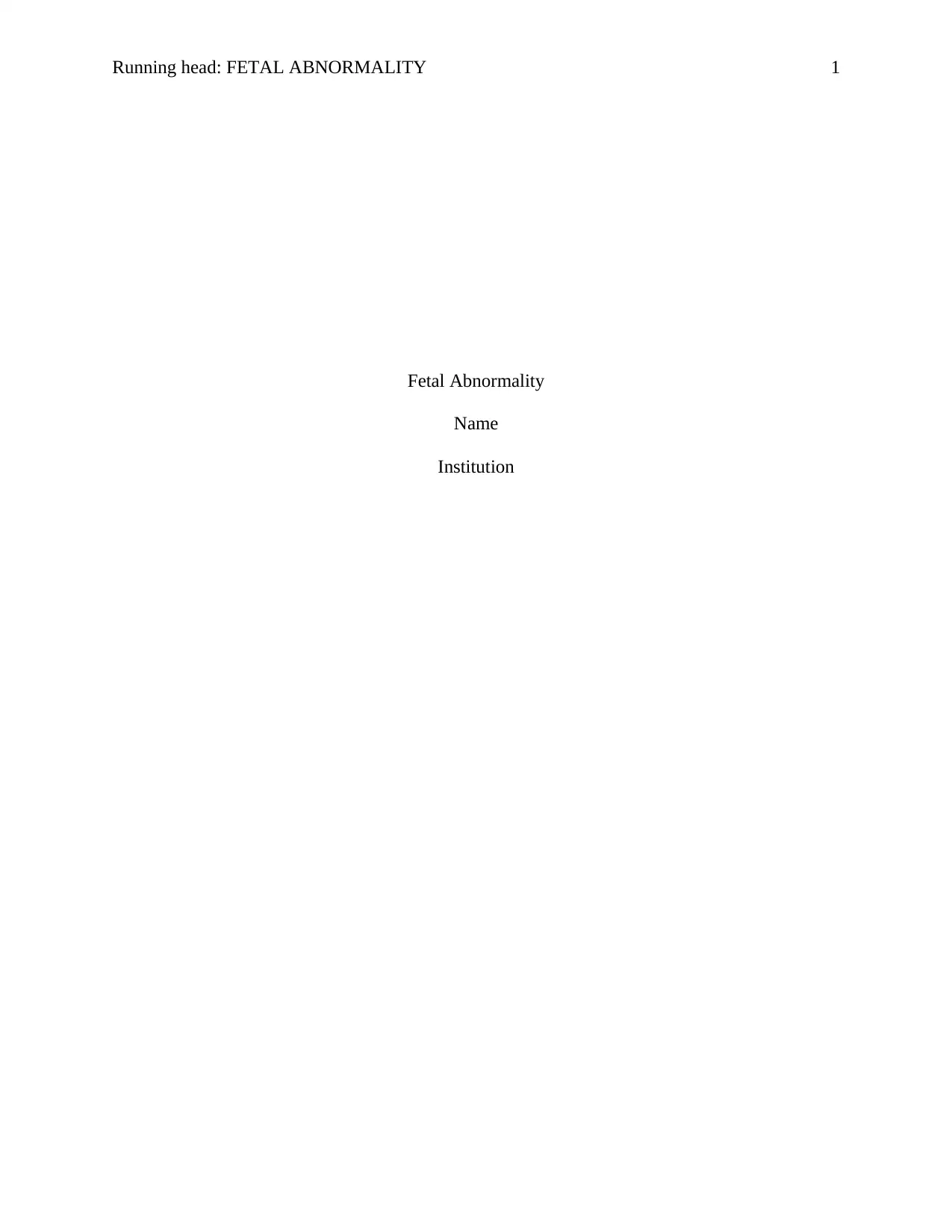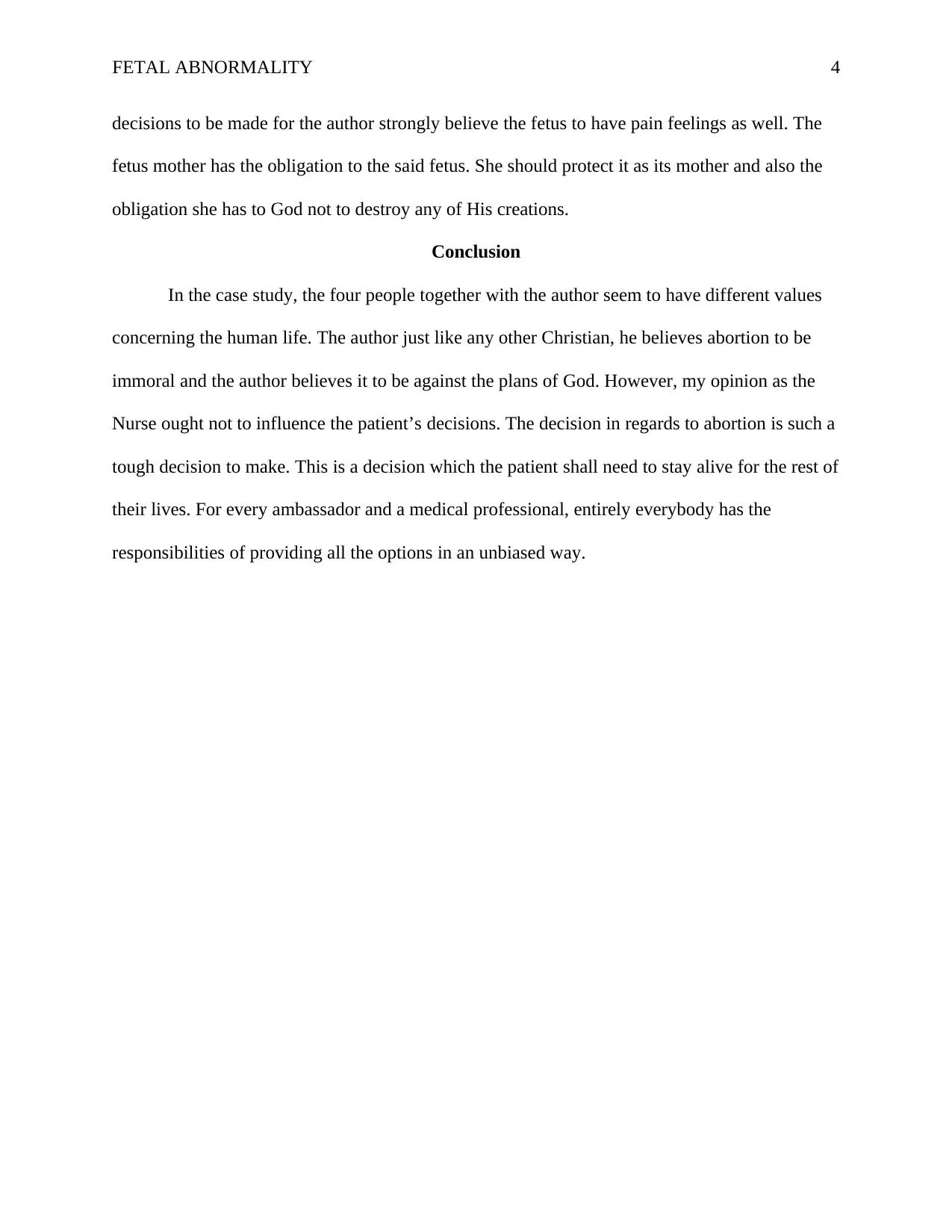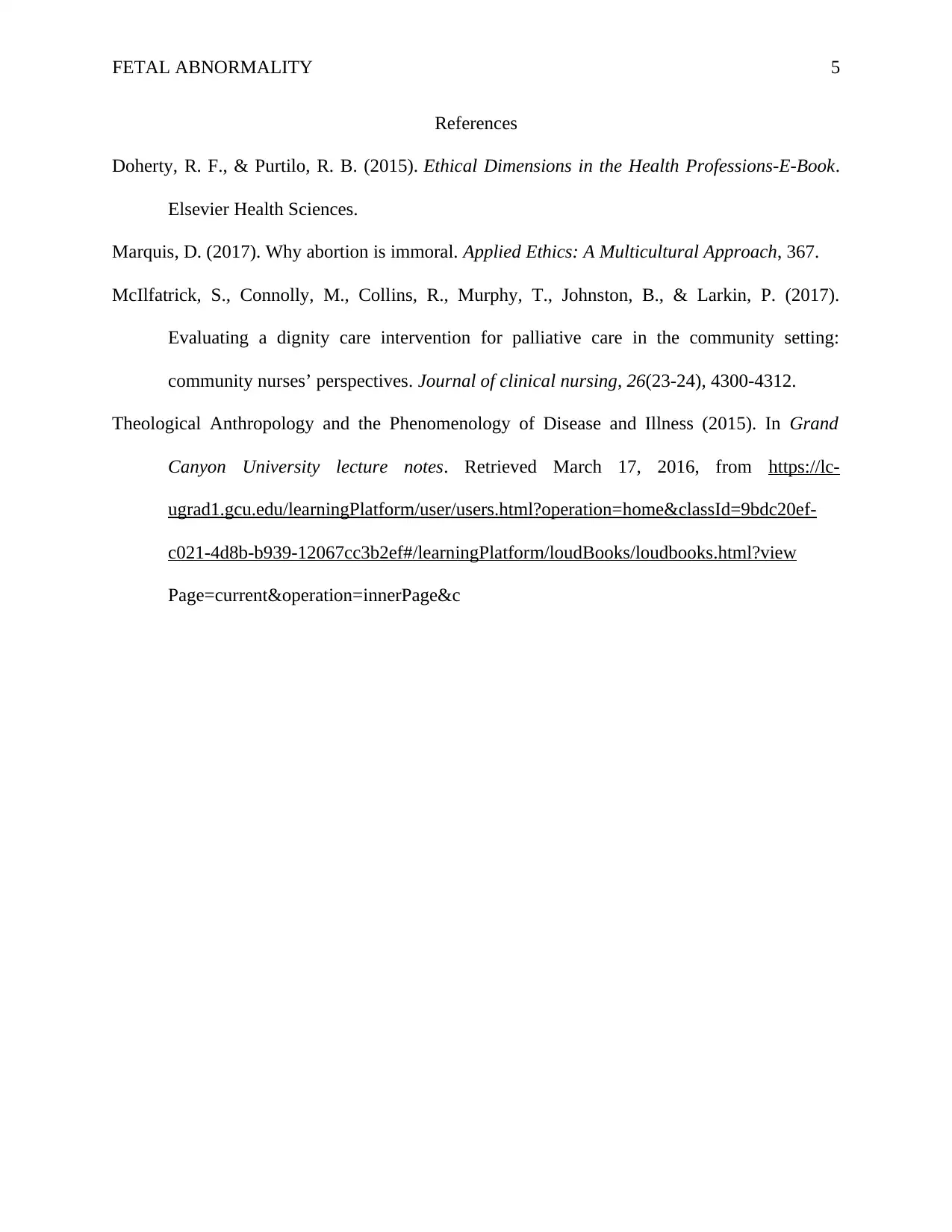Fetal Abnormality Case Study: An Ethical Analysis and Theories
VerifiedAdded on 2023/06/11
|5
|1101
|148
Case Study
AI Summary
This case study explores the ethical and moral dilemmas surrounding a fetal abnormality diagnosis, where a fetus has a 25% chance of Down Syndrome and lacks arms. The analysis examines the perspectives of Jessica (the pregnant woman), her husband Marco, her aunt Maria, and Dr. Wilson, each holding different views on the moral status of the fetus and the decision to abort. The solution applies various ethical theories, including Christian moral theory, cognitive theory, egoism, relationship-based theory, divine command theory, and the theory of moral agency, to understand the reasoning behind each character's stance. The author advocates for the theories of sentience and relationship, emphasizing the fetus's potential to feel pain and the mother's obligation to protect it. The conclusion underscores the importance of providing unbiased options to patients facing difficult decisions like abortion, acknowledging the lasting impact of such choices.

Running head: FETAL ABNORMALITY 1
Fetal Abnormality
Name
Institution
Fetal Abnormality
Name
Institution
Paraphrase This Document
Need a fresh take? Get an instant paraphrase of this document with our AI Paraphraser

FETAL ABNORMALITY 2
Fetal Abnormality
Theories that are used by Maria, Jessica, Marco, and Dr. Wilson
The Fetal Abnormality case study some individuals figured are capable of making their
feelings concerning the abortion of the fetus. The four people presented include Jessica, Maria,
Marco among Dr. Wilson. This scene presents Jessica who is an expectant with a fetus. The fetus
has just 25-percent chances of the Down Syndrome and at the moment without any arms, with a
less likelihood of developing in the future. Jessica’s husband is Marco. He will back up Jessica’s
decision. The religious aunt Maria begs Jessica concerning the obligation she has to God and the
unborn child she is carrying. Dr. Wilson featured supporting the idea to abort the unborn child. A
number of the individuals are posing numerous theories to determine the fetus moral status.
Considering the case study, all the individuals Maria, Jessica, Marco, and Dr. Wilson
have such different views. Their views could be explained based on different theories. Both
Jessica and Maria share same opinions that are based on Christianity perspective. Both Jessica
and Maria decisions they made are aligned with Christianity theory. To Jessica and Maria,
prayers to God and letting His will to be done are the only prevailing opinions. Jessica believes
life to be sacred that is in line with the moral Christian theory (McIlfatrick et al., 2017).
Differently, Dr. Wilson is applying cognitive theory by the way he analyzes what he feels is right
from what he feels is wrong. Dr. Wilson feels so obliged to alert Maria concerning the status of
that fetus. He refused to heed to the request from Marco. Similarly, the decision of Marco is in
alignment with the theory of egoism. His actions are described to be out of self-interest.
Moral status
Dr. Wilson offers the family so many options. However, he mostly supports aborting on
the basis of his medical knowledge on the disabilities. Dr. Wilson utilizes the cognitive
Fetal Abnormality
Theories that are used by Maria, Jessica, Marco, and Dr. Wilson
The Fetal Abnormality case study some individuals figured are capable of making their
feelings concerning the abortion of the fetus. The four people presented include Jessica, Maria,
Marco among Dr. Wilson. This scene presents Jessica who is an expectant with a fetus. The fetus
has just 25-percent chances of the Down Syndrome and at the moment without any arms, with a
less likelihood of developing in the future. Jessica’s husband is Marco. He will back up Jessica’s
decision. The religious aunt Maria begs Jessica concerning the obligation she has to God and the
unborn child she is carrying. Dr. Wilson featured supporting the idea to abort the unborn child. A
number of the individuals are posing numerous theories to determine the fetus moral status.
Considering the case study, all the individuals Maria, Jessica, Marco, and Dr. Wilson
have such different views. Their views could be explained based on different theories. Both
Jessica and Maria share same opinions that are based on Christianity perspective. Both Jessica
and Maria decisions they made are aligned with Christianity theory. To Jessica and Maria,
prayers to God and letting His will to be done are the only prevailing opinions. Jessica believes
life to be sacred that is in line with the moral Christian theory (McIlfatrick et al., 2017).
Differently, Dr. Wilson is applying cognitive theory by the way he analyzes what he feels is right
from what he feels is wrong. Dr. Wilson feels so obliged to alert Maria concerning the status of
that fetus. He refused to heed to the request from Marco. Similarly, the decision of Marco is in
alignment with the theory of egoism. His actions are described to be out of self-interest.
Moral status
Dr. Wilson offers the family so many options. However, he mostly supports aborting on
the basis of his medical knowledge on the disabilities. Dr. Wilson utilizes the cognitive

FETAL ABNORMALITY 3
properties theory, that states that, for the purpose of having a moral status, the individual ought
to be able to prove a level of rationality and awareness that the fetus does not have at all
(‘'Theological anthropology, “2015). However, in the theory, the fetus cannot have any moral
status thus, being so acceptable to do away with it through abortion.
Maria begs Jessica to meditate on the obligation she has as a mother to the child as well
as also respecting the intent of God. The idea falls under this theory on the basis of the
relationship. Similarly, Jessica is deemed related to the said fetus. She is precisely the fetus
parent, a mother. In this regards, she has a relationship with God. All the said relationships give
the fetus a moral status thus criticizing abortion and making it very wrong. Similarly, according
to Marquis (2017), this determines the divine command theory. The theory is on the basis of God
as the sole creator and also deciding morality.
Jessica fears to be in trouble due to the anticipated financial burden that the child can
pose and the religious beliefs she believes oppose the abortion activities. According to Doherty
and Purtilo (2015), Jessica acts more of the moral agent, the individual that acts for herself for
making the most suitable decision. This signifies the theory of moral agency. The reason is that
Jessica shall make choice on the child’s moral status. Marco similarly is more worried
concerning the burden of the disabled child though he is focused on supporting Jessica. This
reveals the theory on the basis of the relationship. This is because the child's moral status might
vary on the bases of choices made by Jessica ("Theological anthropology," 2015).
Author’s Opinion
The author strongly believes much on the theory of sentience and relationship. The
sentient beings are described to poses the moral status and relationship which is determining the
moral status (“Theological anthropology,” 2015). The theory and idea influence the aborting
properties theory, that states that, for the purpose of having a moral status, the individual ought
to be able to prove a level of rationality and awareness that the fetus does not have at all
(‘'Theological anthropology, “2015). However, in the theory, the fetus cannot have any moral
status thus, being so acceptable to do away with it through abortion.
Maria begs Jessica to meditate on the obligation she has as a mother to the child as well
as also respecting the intent of God. The idea falls under this theory on the basis of the
relationship. Similarly, Jessica is deemed related to the said fetus. She is precisely the fetus
parent, a mother. In this regards, she has a relationship with God. All the said relationships give
the fetus a moral status thus criticizing abortion and making it very wrong. Similarly, according
to Marquis (2017), this determines the divine command theory. The theory is on the basis of God
as the sole creator and also deciding morality.
Jessica fears to be in trouble due to the anticipated financial burden that the child can
pose and the religious beliefs she believes oppose the abortion activities. According to Doherty
and Purtilo (2015), Jessica acts more of the moral agent, the individual that acts for herself for
making the most suitable decision. This signifies the theory of moral agency. The reason is that
Jessica shall make choice on the child’s moral status. Marco similarly is more worried
concerning the burden of the disabled child though he is focused on supporting Jessica. This
reveals the theory on the basis of the relationship. This is because the child's moral status might
vary on the bases of choices made by Jessica ("Theological anthropology," 2015).
Author’s Opinion
The author strongly believes much on the theory of sentience and relationship. The
sentient beings are described to poses the moral status and relationship which is determining the
moral status (“Theological anthropology,” 2015). The theory and idea influence the aborting
⊘ This is a preview!⊘
Do you want full access?
Subscribe today to unlock all pages.

Trusted by 1+ million students worldwide

FETAL ABNORMALITY 4
decisions to be made for the author strongly believe the fetus to have pain feelings as well. The
fetus mother has the obligation to the said fetus. She should protect it as its mother and also the
obligation she has to God not to destroy any of His creations.
Conclusion
In the case study, the four people together with the author seem to have different values
concerning the human life. The author just like any other Christian, he believes abortion to be
immoral and the author believes it to be against the plans of God. However, my opinion as the
Nurse ought not to influence the patient’s decisions. The decision in regards to abortion is such a
tough decision to make. This is a decision which the patient shall need to stay alive for the rest of
their lives. For every ambassador and a medical professional, entirely everybody has the
responsibilities of providing all the options in an unbiased way.
decisions to be made for the author strongly believe the fetus to have pain feelings as well. The
fetus mother has the obligation to the said fetus. She should protect it as its mother and also the
obligation she has to God not to destroy any of His creations.
Conclusion
In the case study, the four people together with the author seem to have different values
concerning the human life. The author just like any other Christian, he believes abortion to be
immoral and the author believes it to be against the plans of God. However, my opinion as the
Nurse ought not to influence the patient’s decisions. The decision in regards to abortion is such a
tough decision to make. This is a decision which the patient shall need to stay alive for the rest of
their lives. For every ambassador and a medical professional, entirely everybody has the
responsibilities of providing all the options in an unbiased way.
Paraphrase This Document
Need a fresh take? Get an instant paraphrase of this document with our AI Paraphraser

FETAL ABNORMALITY 5
References
Doherty, R. F., & Purtilo, R. B. (2015). Ethical Dimensions in the Health Professions-E-Book.
Elsevier Health Sciences.
Marquis, D. (2017). Why abortion is immoral. Applied Ethics: A Multicultural Approach, 367.
McIlfatrick, S., Connolly, M., Collins, R., Murphy, T., Johnston, B., & Larkin, P. (2017).
Evaluating a dignity care intervention for palliative care in the community setting:
community nurses’ perspectives. Journal of clinical nursing, 26(23-24), 4300-4312.
Theological Anthropology and the Phenomenology of Disease and Illness (2015). In Grand
Canyon University lecture notes. Retrieved March 17, 2016, from https://lc-
ugrad1.gcu.edu/learningPlatform/user/users.html?operation=home&classId=9bdc20ef-
c021-4d8b-b939-12067cc3b2ef#/learningPlatform/loudBooks/loudbooks.html?view
Page=current&operation=innerPage&c
References
Doherty, R. F., & Purtilo, R. B. (2015). Ethical Dimensions in the Health Professions-E-Book.
Elsevier Health Sciences.
Marquis, D. (2017). Why abortion is immoral. Applied Ethics: A Multicultural Approach, 367.
McIlfatrick, S., Connolly, M., Collins, R., Murphy, T., Johnston, B., & Larkin, P. (2017).
Evaluating a dignity care intervention for palliative care in the community setting:
community nurses’ perspectives. Journal of clinical nursing, 26(23-24), 4300-4312.
Theological Anthropology and the Phenomenology of Disease and Illness (2015). In Grand
Canyon University lecture notes. Retrieved March 17, 2016, from https://lc-
ugrad1.gcu.edu/learningPlatform/user/users.html?operation=home&classId=9bdc20ef-
c021-4d8b-b939-12067cc3b2ef#/learningPlatform/loudBooks/loudbooks.html?view
Page=current&operation=innerPage&c
1 out of 5
Related Documents
Your All-in-One AI-Powered Toolkit for Academic Success.
+13062052269
info@desklib.com
Available 24*7 on WhatsApp / Email
![[object Object]](/_next/static/media/star-bottom.7253800d.svg)
Unlock your academic potential
Copyright © 2020–2025 A2Z Services. All Rights Reserved. Developed and managed by ZUCOL.




